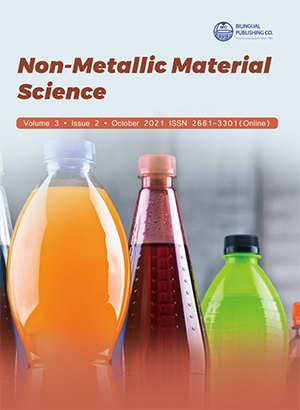-
241
-
225
-
221
-
220
-
128
Structures of Sodium Silicate Glass
DOI:
https://doi.org/10.30564/nmms.v3i2.4070Abstract
The structural model of sodium silicate glass plays a crucial role in understanding the properties and the nature of binary glass and other more complicated silicate glasses. This work proposes a structural model for sodium silicate glass based on the medium-range ordering structure of silica glass and the information found from the Na2O-SiO2 phase diagram. This new model is different from previous ones. First, the sodium silica glass is both structurally and chemically heterogeneous on the nanometer scale. Secondly, the sodium cation distribution is Na2O concentration-dependent. In order to reflect the structural change with Na2O concentration, it requires two different schematic graphs to present the glass structure. The model can be extended to other binary and multiple component silicate glasses and can be experimentally verified.
Keywords:
Continuous random network model; Modified random network model; Nanoflake model; Medium-range ordering structure; Na2O-SiO2 phase diagram; Calcium silicate glassReferences
[1] B. E. Warren, J. Biscoe, Fourier analysis of X-ray patterns of soda-silica glass. J. Amer. Ceram. Soc. 1938, 21[7], 259-265.
[2] W. H. Zachariasen, The atomic arrangement in glass. J. Amer. Chem. Soc. 1932, 54, 3841-3851.
[3] R. H. Doremus, book: Glass Science, Second edition, 1994, John Wiley & Sons. Inc. p. 33.
[4] G. N. Greaves, EXAFS and the structure of glass. J. Non-Cryst. Solids 1985, 71, 203-217. DOI: https://doi.org/10.1016/0022-3093(85)90289-3.
[5] G. N. Greaves, A. Fontaine, P. Lagarde, D. Raoux & S. J. Gurman, Local structure of silicate glasses. Nature 1981, 293, 611-616.
[6] M. I. Ojovan, The modified random network (MRN) model within the configuron percolation theory (CPT) of glass transition. Ceramics 2021, 4, 121-134. DOI: https://doi.org/10.3390/ceramics4020011.
[7] S. Cheng, New interpretation of X-ray diffraction patterns of vitreous silica. Ceramics 2021, 4, 83-96. DOI: https://doi.org/10.3390/ceramics4010008.
[8] S. Cheng, A nanoflake model for the medium range structure of vitreous silica. Phys. Chem. Glasses Eur. J. Glass Sci. Technol. B 2017, 58, 33-40. DOI: https://doi.org/10.13036/17533562.57.2.104.
[9] R. Cotterill, book: The Cambridge Guide to the Material World, 1985, Cambridge University Press, London. p. 78.
[10] F. C. Kracek, The system sodium oxide-silica, J. Phys. Chem. 1930, 1583-1598.
[11] S. Cheng, Medium range ordering structure and silica glass transition, Glass Physics and Chemistry 2019, 45(2), 91-97. DOI: https://doi.org/10.1134/s1087659619020093.
[12] W. Vogel, book: Chemistry of Glass, The American Ceramic Society, Westerville, Ohio, (1985).
[13] O. V. Mazurin and E.A. Porai-Koshits, The structure of phase-separated glasses, in Phase Separation in Glass edited by O. V. Mazurin and E. A. Porai-Koshits, North-Holland (1984).
[14] R. H. Doremus and A.M. Turkalo, Phase separation in pyrex glass, Science, 1969, 164 418.
[15] E. A. Porai-Koshits & V. I. Averjanov, Primary and secondary phase separation of sodium silicate glasses, J. Non-Cryst. Solids, 1968, 1, 29-38.
[16] S. Cheng, C. Song, P. Ercius, Nanophase structures of commercial pyrex glass cookware made from borosilicate and from soda lime silicate. Phys. Chem. Glasses Eur. J. Glass Sci. Technol. B 2015, 56(3), 108-114.
[17] S. Cheng, C. Song, P. Ercius, Indentation cracking behaviour and structures of nanophase separation of glasses. Phys. Chem. Glasses Eur. J. Glass Sci. Technol. B 2017, 58 (6), 237-242. DOI: https://doi.org/10.13036/17533562.58.6.040.
[18] B. Phillips & A. Muan, Phase equilibria in the system CaO-iron oxide-SiO2 in Air. J. Am. Ceram. Soc., 1959, 42(9), 413-423.
[19] P. H. Gaskell, M. C. Eckersley, A. C. Barnes & P. Chieux, Medium-range order in the cation distribution of a calcium silicate glass, Nature. 1991, 350, 675-677. DOI: https://doi.org/10.1038/350675a0.
[20] M. C. Eckersley, P. H. Gaskell, A. C. Barnes & P. Chieux, Structural ordering in a calcium silicate glass, Nature. 1988, 335, 525-527. DOI: https://doi.org/10.1038/335525a0.




 Shangcong Cheng
Shangcong Cheng






